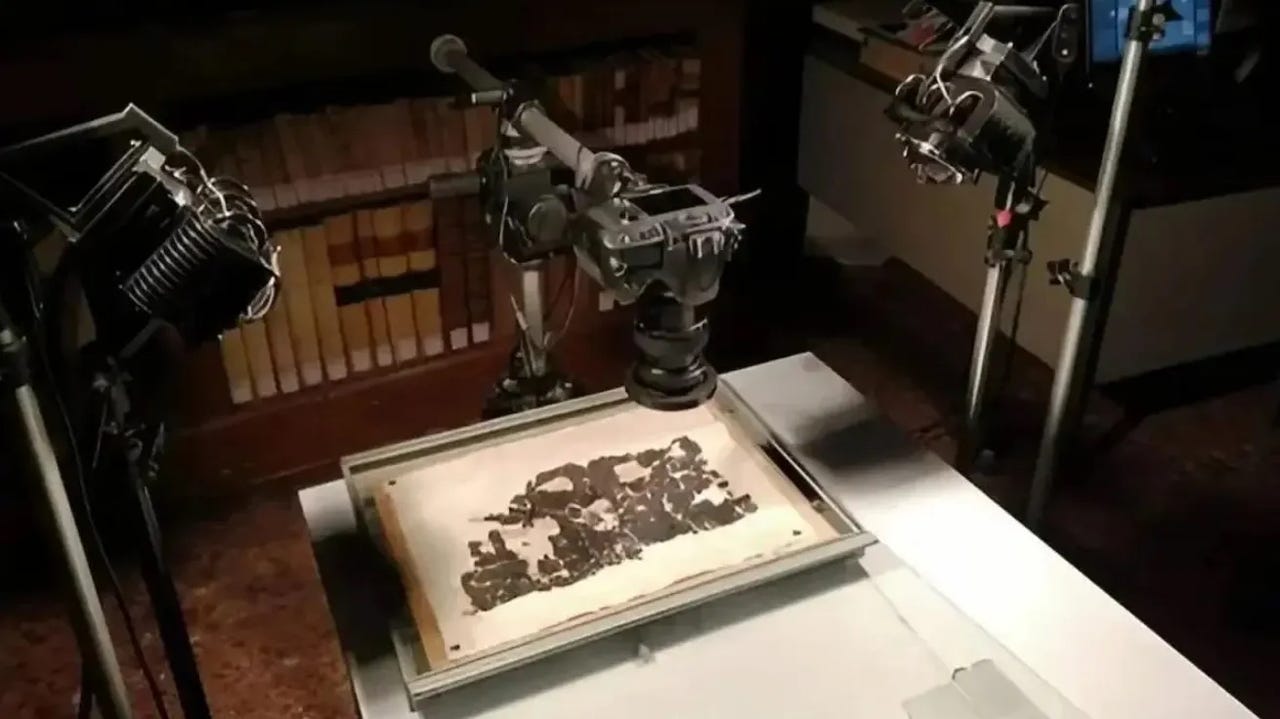AI just helped us find out where Plato is buried - here's how


Artificial intelligence (AI) is accelerating new discoveries across industries, from video production to medicine -- and now, it's expanding what we know about antiquity.
On Tuesday, researchers at the University of Pisa in Italy announced that they have successfully used AI to decipher a papyrus scroll found in Herculaneum, a town near Pompeii that was also destroyed when Mount Vesuvius erupted in AD 79. The scroll is one of 1,800 scrolls preserved in the Villa of the Papyri -- once owned by Julius Caesar's father-in-law -- when the estate was buried in mud and ash.
Also: AI breakthrough enables scientists to read Roman scrolls once buried by Mount Vesuvius
Because the scrolls are carbonized and therefore too fragile for human touch, they must be deciphered using hands-free scanning technology. According to ANSA, the researchers used infrared hyperspectral imaging and optical coherence tomography (OCT) to see through the charred papyrus.
By identifying and translating 1,000 words, or roughly 30%, of the scroll, the team discovered Greek philosopher Plato's final resting place: a garden at the site of the Platonic Academy in Athens. The text also reveals that Plato was sold into slavery in either 404 or 399 BCE -- not 387 BCE, as historians believed prior to Tuesday's discovery.
The reveal emphasizes the potential of this technology to further refine our historical knowledge of this era and its most prominent figures.
The discovery follows the February breakthroughs of the Vesuvius Challenge, a global contest launched in March 2023 to decode the entire collection of Herculaneum scrolls. As the last intact library from antiquity, the scrolls could yield fascinating pieces of history.
The project's primary technology uses a combination of computed tomography (CT) scans and machine learning to decipher what's written on the scrolls without the need to disrupt them physically. ZDNET went in-depth with University of Kentucky researcher Brent Seales, one of the people behind the Challenge, about the project's findings earlier this year.
Also: How AI hallucinations could help create life-saving antibiotics
In short, the process has three steps: scanning, segmentation, and ink detection. Researchers create micro-CT scans of the insides of the scrolls, segment scans into individual pages, and then decode what's written on them using machine learning.
Because the scrolls and their ink are carbonized from the volcanic eruption, they're essentially black-on-black, making them hard to distinguish by a computer. Researcher Stephen Parsons worked with Seales to train an ML model to read the carbon text. The team then created Volume Cartographer, an open-source software that makes sense of the text.
Researchers are still grappling with a few challenges, including applying the models to full scrolls as opposed to fragments, creating more "ground truth data" to improve model accuracy, and reverse-engineering the models to uncover the patterns they use to detect ink, according to the Vesuvius Challenge's website.
Also: Ready to implement AI at work? Google has a new course for that
This year, the Challenge will attempt to transcribe entire scrolls by scaling both the segmentation and scanning parts of the process. "We will set as our target for 2024 to read 90% of Scrolls 1-4, and offer a $100,000 grand prize to the first team to achieve this milestone," the site says.
The University of Pisa discovery is a testament to what AI can uncover that would otherwise be unknowable. As Challenge researcher Michael McOsker told ZDNET, this approach could help unravel the equivalent of about 200 new books from the Herculaneum library.
The potential doesn't end there. Researchers also believe this tech can be applied to other fields, where machine learning could improve what CT scans and MRIs can detect, such as tumors in medical imaging. They're currently working on virtually rendering a medieval manuscript from New York's Morgan Library.